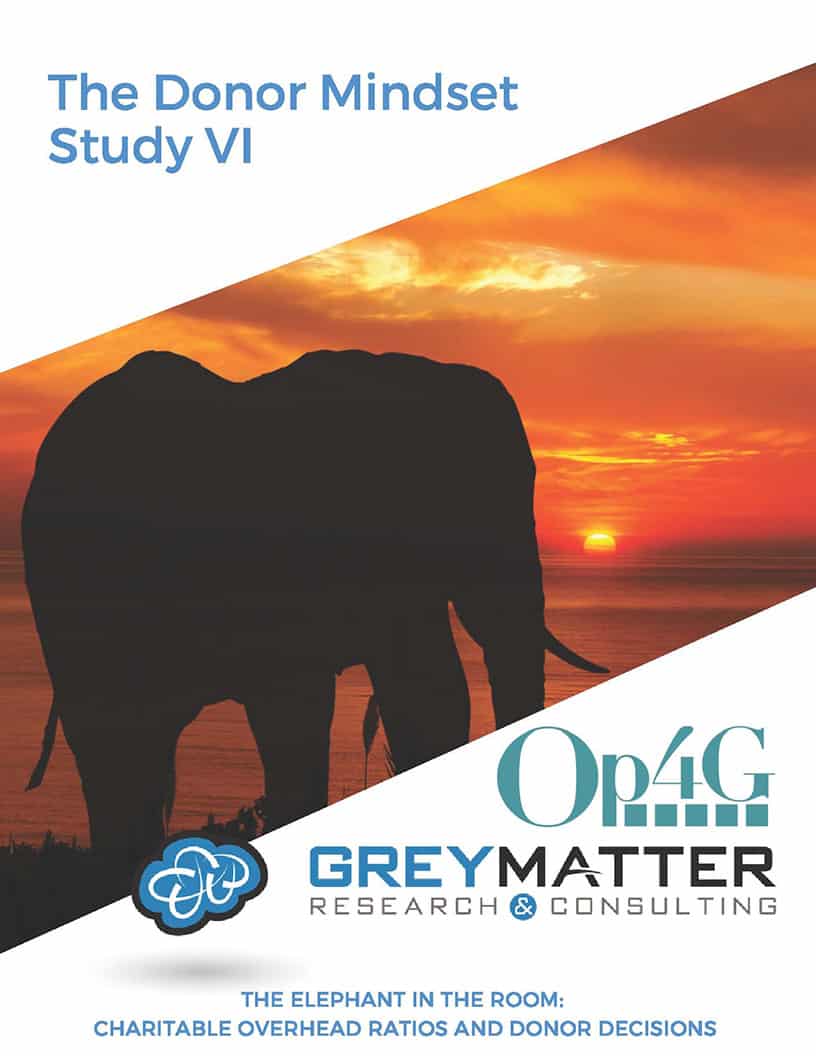
Donors pay far less attention to overhead ratios than do charities and charity watchdog organizations.
Is the Overhead Ratio Critical?
Most American donors feel the typical non-profit spends too much on overhead, administration, and fundraising. (This is called the “overhead ratio.”) The average donor considers 19% spent on overhead to be a reasonable limit. However, that same donor believes the typical charity spends 28% on overhead.
Donors usually have no idea what their favorite charity actually spends on overhead. There is widespread belief charities spend too much. But, nearly half of all donors have a favorite charity reporting an overhead ratio of 20% or higher.
Consumer insights company Grey Matter Research created The Donor Mindset Study. It’s a series of research reports about American donors. The latest study in the series is The Elephant in the Room. The report explores how donors see charitable overhead ratios. It also examines what they actually know about their favorite organization’s spending.
Who Pays Attention?
Donor-supported organizations tend to pay a lot of attention to their overhead ratio. They often believe donors strongly value this number. Charity watchdog organizations also emphasize it. But the research shows, in reality, donors pay far less attention to the overhead ratio than is often assumed.
The charitable sector as a whole has a reputation problem. Nearly six out of ten American donors believe the typical charity spends more than a reasonable amount on overhead. Not only that, but donors often believe the overspending is substantial. Half who feel charities overspend also feel they typically spend at least double what they should on overhead, administration, and fundraising.
Changes Since 2012
These numbers can be compared to a similar study conducted by Grey Matter Research in 2012. Donors in 2018 believe overhead spending is lower than donors in 2012 believed, with the average shrinking from 34% to 28%. But 2018 donors also have more stringent expectations for what is acceptable. What they define as a reasonable overhead ratio has dropped from an average of 22% in 2012 to 19% in the 2018 study.
The report notes the sector’s poor reputation in this area may actually benefit many individual organizations. “If you believe the typical charity spends 28% on overhead,” the report observes, “ratios as high as the low-to-mid 20s would seem lower than average, even if they’re a tick above what you consider to be reasonable spending.” An organization with an overhead ratio of 16% or 20% will look much better than average if you believe the average is high.
Not as Important as You Might Think
Despite how they see the sector as a whole, donors frequently show they don’t value or even pay attention to low overhead ratios as much as it is often assumed. Consider the following:
- The average donor believes 19% is a reasonable ceiling for overhead spending. But nearly half of all donors name a favorite organization with an overhead ratio exceeding this.
- Only 11% of all donors name a favorite charity with a seriously low overhead ratio (below 10 cents on the dollar).
- About half believe their favorite charity’s overhead ratio is higher than it actually is.
- Four out of ten believe their favorite charity’s overhead ratio exceeds what they feel is a reasonable limit. Yet, that organization still remains their favorite charity.
- When asked their primary reason the organization they named is their favorite charity, just 12% say it’s because the organization uses their money very efficiently.
Donors also demonstrate little awareness of actual charitable overhead ratios. When asked how much their favorite charity spends on overhead, nearly two-thirds of donors lack confidence their answer is reasonably accurate. And they’re right to lack confidence: even among those who feel very confident they know their favorite charity’s overhead ratio, seven out of ten are off by at least 50%.
Time to Re-evaluate
Ron Sellers, president of Grey Matter Research, notes charitable organizations may need to re-evaluate the importance of keeping overhead ratios as low as possible. “In a variety of ways, our research demonstrates overhead ratios are not as important to donor decisions as many people believe,” Sellers explains. “Placing too much focus on keeping expenses very low can restrict available resources and harm an organization’s ability to attract and retain talent, take reasonable risks, and invest in systems and infrastructure that will aid future growth and efficiency.”
Sellers noted this study focuses on typical spending, not the occasional abuse that is seen in the sector. “This research doesn’t mean an overhead ratio of 60% would be acceptable to donors. This is not a blank check for profligate spending, nor are donor perceptions the only reason to keep overhead reasonable. But we see no evidence scrimping to drop your overhead ratio from 19% to 16%, for example, will make your organization significantly more appealing to donors.”
The full study examines these donor perceptions more in-depth, with considerable detail. Please e-mail ron@greymatterresearch.com for a free copy of the full report.
About Grey Matter Research
Grey Matter Research is a consumer insights company with extensive experience helping donor-supported organizations. Grey Matter works directly with charities and ministries. We also serve with the fundraising, branding, and marketing services agencies that support them.
